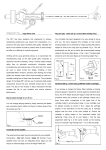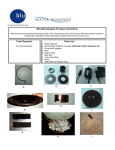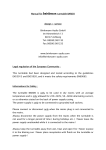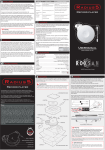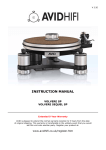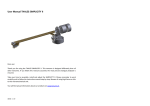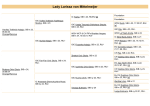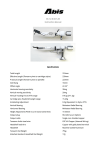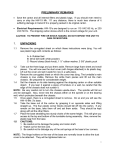Download im stabi xl4 101014
Transcript
Fig.1 KUZMA STABI XL 4 TURNTABLE ………………….. ( on photo black with Stogi Ref 313) Instruction manual 2010-10 1 KUZMA LTD INSTRUCTION MANUAL FOR STABI XL4 turntable The Stabi XL 4 turntable is a very precisely engineered piece of equipment. However the construction is robust and requires minimal mainentance for optimal performance. CONTENTS: Page General Unpacking Basic Setup Setting up turntable Use and Adjustment Mainentance Problems 3 4 5-6 7-8 9 10 11 2 General Description: The turntable is packed in four boxes. Some parts are very heavy so handle boxes with care . The base is of solid brass which is clamped together from two pieces and has good damping properties. The main shaft, which is 28 mm in diameter, is fixed into this base. The platter is a sandwich construction of aluminium and acrylic plates screwed together in a pre-stressed form to damp all unwanted vibration. Hard non-metalic material is used for the bearing which, together with a ruby ball, is lubricated in an oil pool to provide one point contact ensuring minimal vibration and noise. The position of the platter is further stabilised by a sliding non – metal ring, precisely matched to the shaft diameter and immersed in a second large oil pool. Four motors are mounted separately in their own heavy brass towers. Four pulleys, via four belts, give stable symetrical drive to the subplatter. The electronic power supply generates controlled feed to four motors, in such a way that the vibration of the motors is minimised. A heavy threaded brass and acrylic clamp provides additional damping of vibration caused by playback, as well as flattening curved records. The record is pressed securely to the plattermat, which is a semi-hard combination of rubber and textile. The tonearm tower is a massive brass unit and the armboard can be exchanged to accommodate various tonearms. The mass of the tower gives structural and damping rigidity to the tonearm. The unit allows for VTA adjustment during playback without loss of rigidity or azimuth. The movable part is supported via a linear ball bearing 30 mm in diameter and 100 mm in length. This gives firm support while allowing VTA to be changed. Adjustments can be made over a range of 60 mm, each turn of knob representing 1 mm precisely. In order to simplify adjustment, a micrometer gives a digital readout over a range of 12mm at an exactitude of 0.01 mm. These adjustments are repeatable. Stabi XL 4 turntable :Technical data Mass (total w/o PS) : 96kg Platter: 22 kg Base: 27kg Motor towers: 4 x 7kg Tonearm tower: 14 kg Speeds (fine adjust): 33, 45 rpm Dimension: 450x 400 x 300 mm Power supply: 110V or 240 V , 50/60Hz (factory set) Optional: use two more towers, tower without VTA for all arms( no.3) Safety Precautions: Electrical connection to the power supply from the mains comes via the cable. Please keep PS away from moisture and be careful not to damage the mains cable. The same precaution applies to cables feeding the motor towers. 3 Unpacking: Stabi XL 4 comes packed in four boxes. Be aware that the three larger boxes are very heavy. These boxes have double packaging. Inside are cutouts in the packaging blocks of firm foam for various parts of the turntable. Some parts are very heavy, so handle with care while lifting from the boxes and placing them on the assembly surface. Contents: Box 1: Platter and two motor towers Box 2: Tonearm tower, base, subplatter, clamp, VTA guage. Box 3: Power supply, belts 4x, motor cables 4x, bearing oil bottle 2x, clamp washers 2x, power cord, Allen keys: 1.5 , 2 , 2.5, 3 mm, motor positioner, instruction manual. Box 4: Two motor towers, two motor tower supporting plates. Basic Setup: Note: Some parts are very heavy, so be careful when handling! Note: Choose a suitable supporting table which can hold over 100 kg without warping. Note: While the parts are packed in plastic bags for protection, these are not intended to be strong enough to lift or carry the contents. Open all three boxes and remove top covers. 4 Base: Locate the main brass base with the shaft. This is very heavy. Lift, being careful not to scratch against metal parts of clothing, and position in the middle of the supporting board. The Kuzma logo should face forward. Use a ruler to position the centre of the base. Subplatter: Remove the protection cover from the shaft and see if there are any dirt particles in the area of shaft and ruby ball. Remove these using a soft cloth and further clean the area if necessary with a cloth soaked in alcohol. Oil should be poured into the reservoir on top of the shaft (where the ruby ball is located ) until it is full and oil starts to run into the lower reservoir. Then empty the rest of oil into this lower reservoir. The level of oil is not critical due to the construction of the bearings. Note: there is a spare bottle of oil! Carefully put the aluminium subplatter over the shaft as vertically as possible and gently lower by rotating it back and forth. When lowered, ensure that rotation of the subplatter feels free and firm. If your hands are sweaty or sticky from the oil, clean the outer surfaces of the subplatter with a cloth soaked in alcohol. Fig 3 Motor towers: Remove the two brass motor towers with the black pulleys, being careful not to touch the pulleys with any force. Position each motor separately, one in front of the base(the motor tower with the Kuzma logo) and the second motor tower at the rear of the base so that the connectors are at the rear side. All four motor towers should form a square. The gap between the base and the motor towers should be at least 20 mm. See fig 2.Then add supporting plates for motor towers. The thinner plate raises the front motor tower and the thicker plate supports the rear motor tower. Reposition motor towers to achieve 112 mm distance from subplatter to outer edge of motor pulley after positioning platter. Use motor positioner on top of pulley by simply just touching the edge of the platter. See fig 4. 5 Distance of motor towers. Fig. 4. Belts: Place one belt over both motor pulleys in the lower running grooves and subplatter and check by manual rotation that the belt runs smoothly in the middle of the grooves. Then place the second belt in the top running grooves on the motor pulleys and subplatter. Position of belts from lowest upwards: 1-old tower-right- lower groove 2-old tower-left- upper groove 3-new tower-front-upper groove( thinner support plate) 4-new tower-rear-lower groove ( thicker support plate) Recheck the position of belts. Power supply: PS XL 2=4 Position the PS on a firm surface away from signal cables and ensure there is adequate ventilation, ie. leave a gap of at least 2 cm above the unit. Locate the 4 pieces of connecting cables with DIN connectors. On the rear plate of the power supply and at the back of the motor towers are DIN connectors, one for each motor. Connect cables by inserting plugs into the sockets and rotate locking collars. It does not matter where each motor is connected. Plug in the mains cable. 6 General description of PS XL 2 ( MCU): The AC motor power supply generates dual sine wave ouput to control rotation and speed of the AC sycnhronous motors. The signal is generated and controlled by a sophisticated computer based program. This allows for very smooth generation of the sine wave with very fine choice of speed. Each speed can be selected, finely adjusted independently and then stored in the memory. PS is factory preset. Connect motor cables to motor outputs(any ). Sometimes it will take a few hours for a new turntable to settle for the correct speed. When the PS is unplugged preset speeds will be stored. Technical data: Mass: 2 kg Size: 120x140x400 mm Power consumption: 50w Output: 33,45 rpm( 40-100Hz, 110V) Mains: 110V or 230V ( 50-60Hz) Check the belts again to ensure they run smoothly in the appropriate grooves. Platter: Carefully put the platter on the subplatter. The best way to do this is for one person to hold the platter while another person positions it over the subplatter, helping to lower it down. Be careful not to scratch the platter with jewellery etc. Check that the platter is resting on the subplatter. Full speed should be obtained within 30 seconds (15-20). See front page. 7 Tonearm tower: Position the tonearm tower in the approximate normal tonearm position. Ensure that the tonearm tower is not touching the platter, base, or motor towers. Position the tower so that the VTA toothed knob is facing away from the platter and that the parts holding the measuring guage are facing towards the front. For Kuzma tonearms the gap between platter and tower is 5 mm. See Fig. on page 2. By rotating the VTA knob conterclockwise, raise the height of tonearm tower to slightly below the top surface of the platter (10-20 mm). If your tonearm tower comes with an appropriate cutout for your tonearm, measure the distance from the spindle to the centre of the tonearm tower. When used with our tonearms this should be 212 mm. The top brass round plate is removable and different tonearm cutout brass plates are available from your dealer. Rotation of the top brass plate against the tonearm tower is easily done. Just release the two side screws with Allen key 3 mm. The position of the tonearm tower in relation to the perimeter of the platter does not affect the tonearm geometry, so the tower should be placed for convenience of use. The only critical parameter is the distance to the platter centre. Underneath the toothed VTA knob is a screw for securing the VTA , to prevent this being accidentally changed ( using Allen key 1.5 mm). 8 Setting up the turntable: Tonearm: Ensure that the supporting stand is completely horizontal. When the Air Line tangential tonearm is used additional fine adjustment of turntable horizontality is mandatory. Mount the chosen tonearm according to instructions. Firmly secure the armbase onto the tonearm top brass plate and secure it with two screws, using Allen key 3 mm, at the side of the tower. See Fig.3 Fixing screws on top of the tonearm tower.Fig.3. Raise the tonearm to an appropriate height above the platter. Position the tonearm cable towards the back of the turntable towards the phono input. Check the length. Check again the spindle to tonearm distance and rotate tower to be in an optimal operating position. VTA Guage: Hang the digital display on the front of the tonearm tower using the lever and screw at the bottom of the tower. Ensure that the display does not touch the platter or motor towers. The display can be left in the 'ON' position for up to three years (battery). Pressing 'origin' will cause 0.00mm to show. Switching to + or – will cause this sign to appear in front of the numbers. Pressing (press and hold for about one sec) to 'origin' again, resets the display to zero. Due to the limits of height measurement (12 mm), the display should show the middle of the measurement. An appropriate height for the tonearm is when the tube is parallel to the record after the cartridge is mounted. 9 Setting the VTA Guage: With Allen key 1.5 mm release the small brass weight which holds the display in the upper position. The display will show minimum. Reset and the measurement will show zero. Lift the vertical rod for about 6-7 mm (middle) and with Allen key, secure this position with the screw on the brass weight. Then again reset and it will show that this new position is zero. Raising the VTA by rotating the toothed knob, will show increased height above this reference point in mm and lowering it will show minus numbers. The precision achieved by this is 0.01 mm. If the change in height of the tonearm comes outside this range of measurement, the brass weight can be repositioned. The measuring device will not be damaged by being outside its range. Each rotation of the knob corresponds to 1mm change in VTA and can even be moved while playing records. 10 Use and adjustments: Platter rotation& Speed selection: 1.Press firmly the power button the front panel. After 10 sec the PS is ready. The display will show 33 and above the start button a red LED will be shown. You can keep the PS switched on all the time. 2.By pressing the start button the red LED will turn green and the platter should start rotating. To stop platter simply press the start button again. The red LED will show and the platter will stop rotating. 3. Press the speed button and the selected speed will change from 33 to 45. Press again and it will return to 33. But for speed 45rpm, first always start up with 33rpm and then switch to 45rpm. 4.Do not hold pressed start button before mains switch is on. Fine Speed adjustment: Observe on a strobe disc if the bars are stationary. If not ( bars move in the same direction as platter rotation then the speed is too high) then press few times( there are very small steps- so keep pressing) the plus or minus buttons until the bars are stationary. On the display you will see a green dot in the right bottom corner indicating that change is in process. Using a sharp pen, press the store button and the green dot will disappear. Check speed independently for both speeds. When using the strobe disc, be sure that you use properly. Check that you are looking at the correct speed and are using the correct strobe light ( household light which depends on mains frequency). Clamp: The clamp can be used without washers. Gently screw down the clamp on top of the record. Put a washer under the LP (thin for thick records and thick for thin records) and start screwing the clamp down. Observe the outer edge of the LP. To start with, this edge will be above the mat but will slowly lower to touch the mat. With fingers hold the LP so that it does not rotate. If the clamp is further screwed, the outer edge will rise. Pressure should then be released by slightly unscrewing the clamp until the outer edge is touching the mat again. This is the position in which the record is held in firmest contact with the mat. With practise there is no need to stop spinning the platter while changing LPs or using the clamp. VTA change: Rotation of the toothed knob at the base of tonearm tower raises and lowers the top part of the tonearm tower (seen from the top, counterclockwise rotation raises VTA). Adjustments can be in repeatable increments below 0.01 mm. Rigid construction allows for this to be done while records are playing, without changing azimuth. For more details see the sections on tonearm tower and VTA clock. 11 Mainentance: Mat: The top surface of the mat can be cleaned using a roller textile cleaner. Bearing: Oil in the bearing will last for 3-4 years or more. Running the bearing without oil will do no harm due to the choice of materials and type of construction. Oil should be added if the top reservoir (with ruby ball ) is totally dry. The oil level will be below the ruby ball as, when the subplatter is lowered onto the shaft, the bearing surface increases the level of oil above the ruby ball. When the subplatter is removed you can see the level of oil inside its sliding ring ( brown colour). If it is above the sliding ring in the subplatter, there is plenty of oil. If excess oil is added it will run into the appropriate extra reservoir. Belts: Periodically remove the platter and remove the belts. Clean belts and running surfaces of the motor pulleys and the subplatter with a soft cloth soaked in alcohol (every 8-12 months). For best performance replace belts every three years. VTA Guage: The sign 'B' in the top left corner of the clock indicates that the battery should be replaced. Remove the battery cap by turning it counterclockwise with a coin and remove old battery replacing with a new battery with the + side facing up. Secure the battery cap. Immediately after the battery has been set, a meaningless display or 'E' will appear. This is quite normal so merely continue to set up 'origin' again. 12 Problems: Platter not rotating: Power supply- check if green display and red LED is on -check selector to 33 rpm - check connection cables from PS to motor Consult dealer or qualified electrician. Very slow start: Only one motor is connected or one output channel of the PS has failed. Remove the platter and belts and check that the motor pulleys are rotating. If only one motor pulley rotates, disconnect the mains and connecting cables from the PS and reconnect the non- rotating motor to the output of the second motor to check is there is a motor failure or a failure of the PS. Wrong speed: If you find out that your speed selection is out of range for some reason you should reset PS to factory sert outputs. Turn the power off, wait 10 sec and then press and hold speed button, then press power on. When display will shows CU, release the speed button. The display will now show FA and then 33. Your PS is now preset for factory preset speeds. A.Speed:To reach correct speed, adjusted it on the PS. Also check that the distance of motors to the platter are correct. B.If the speed is totally incorrect: Reset to factory preset. Finally repeat factory preset and fine speed adjustment. Transportation: For short distances dismantle the platter, remove belts and disconnect all cables. The base with the subplatter can be transported as one, providing that it will not be tilted, as this may cause oil leakage. All parts are heavy, however, and can be easily damaged by sliding around a transport vehicle. Repacking in original cutouts and boxes is , therefore, recommended. Kuzma Ltd Hotemaze 17A SI-4205 PREDDVOR SLOVENIJA Phone:+ 386 4 25 35 450 Fax: + 386 4 25 35 454 E mail: [email protected] www.kuzma.si 13













